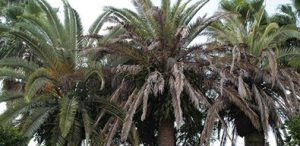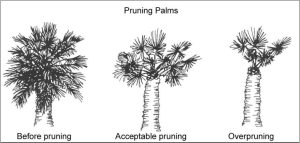Planting Site
Palms in the Phoenix genus are drought tolerant and should be planted in well drained soils. Depending on the species, Phoenix palms can be 6 to 80 ft. tall at maturity, with P. roebellini being the shortest in the genus and P. dactylifera being the tallest. Phoenix palms also have a mature spread from 6 to 25 ft. depending on the species, so it is important to account for this prior to selecting an appropriate planting site. Although Phoenix palms thrive in full sun, some species such as the P. roebellini, will tolerate partial shade. Based on he UF/IFAS Invasive Species Assessment, P. reclinata is categorized as ‘invasive’ for South Florida. To learn more about invasive plants click on this link: invasive plants.
 Nutrient requirements
Nutrient requirements
Due to their prolific fruiting tendency, Phoenix palms can experience significant nutrient deficiencies, most commonly potassium and magnesium, which if not addressed, can lead to declining health. Palms do best when fertilized with specially formulated fertilizers that provide nutrients in appropriate proportions. Symptoms of nutrient deficiencies typically include yellowing fronds or yellow/brown spots on fronds. Click on this link to learn more about palm nutrient requirements: fertilizing palms.
 Pests and diseases
Pests and diseases
Lethal Bronzing Disease (LBD) can be a major problem for some Phoenix species, notably P. canariensis. LBD is a phytoplasma transmitted by an insect vector and causes rapid decline. Symptoms include browning/bronzing of fronds and spear-leaf failure. For more information on LBD, click on this link: Lethal Bronzing Disease.
 Pruning
Pruning
When pruning palms, proper pruning guidelines should be followed, removing only spent flower stalks, immature fruit, and brown fronds. Because palms have unique nutritional requirements, over-pruning palms can result in nutrient deficiencies and make them susceptible to pests and diseases. Click on the link to learn more about pruning palms.
Learn more:
For more information on date palms, click on this link.
 2
2
 Included in the Phoenix genus of palms (USDA Hardiness Zones 8 to 11), are: P. reclinata (Senegal date palm), P. canariensis (Canary Island date palm), P. dactylifera (Date palm), P. silvestris (Silver date palm), and P. roebellini (Pygmy date palm).
Included in the Phoenix genus of palms (USDA Hardiness Zones 8 to 11), are: P. reclinata (Senegal date palm), P. canariensis (Canary Island date palm), P. dactylifera (Date palm), P. silvestris (Silver date palm), and P. roebellini (Pygmy date palm). Pests and diseases
Pests and diseases Pruning
Pruning